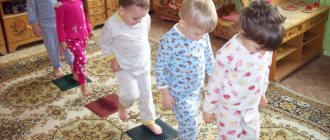My kindergarten
Author: Maria Sergeevna Shpet , teacher-psychologist, MAOU Secondary School No. 30 DO, Tomsk.
Explanatory note
Relevance
Group cohesion is a necessary condition for creating a comfortable microclimate in the team. Group cohesion is promoted by: a positive emotional state of teachers, a friendly, inviting atmosphere in the group; positive relationships and sympathy between participants, mutual understanding. Thus, when a comfortable microclimate is created in a group, its participants gain confidence and strive to work and create. Team building training is one of the effective ways to create such an atmosphere.
Program goal: increasing team cohesion
Tasks:
- Improving the emotional state of teachers
- Promote positive relationships and mutual understanding between teachers
- Relieving emotional stress of teachers
Progress of the training
Teacher-psychologist: Good afternoon! I am glad to welcome you to our training! Today we have the opportunity to relax a little, relax, play, learn a little more about ourselves and our colleagues, and most importantly, become a little closer to each other.
Exercise "Let's say hello"
Psychologist: At the beginning of our meeting, I propose to say hello, but we will do it in an unusual way. First of all, we need to break into pairs (teachers form pairs). If you hear 1 clap, we shake hands, 2 claps, we shake shoulders, 3 claps, we shake our backs. During the task we remain silent, only parts of our body say hello. When I ring the bell, your task is to find a new partner.
Game "Magic Hat"
Psychologist: What can make a meeting pleasant? (statements from teachers). A compliment will make any meeting pleasant. We will pass the hat around in a circle while the music is playing, when the music stops, the one who still has it puts it on himself and pays a compliment to the person sitting on the right. It is necessary not only to receive a compliment, but also to return it. A compliment is accepted in a certain form: Yes, it is! And I…(a positive quality is added) and the compliment is returned to the speaker.
Exercise “Recognize the drawing”
Teacher-psychologist:
Each of us received a compliment. A compliment improves your mood and allows you to look at yourself differently. Please draw in 5 (10) minutes a portrait of yourself, how you see yourself in the team or want to see yourself. There is no need to sign the drawings.”
After completing the work, the trainer collects the drawings into a common pile. Then he takes each drawing out of the pack, attaches it to the board or flipchart (you can first pass the drawing around so that everyone can take a closer look at it) and discusses it with the group on the following questions:
- What is this person like?
- Who could it be?
Participants guess the author of the drawing. After the group has found out who the author of the drawing was, the coach asks him to pick a flower and finish the sentence he started.
Exercise "Flower"
Each flower has a saying written on it that needs to be completed: I am proud... The thing I want most... The person I admire is... The thing I love the most... I dream... Three places I've lived.. Three things I like... Three things that I don't like... My hobby... You don't know about me yet that I...
Exercise "I'm just like you"
Teacher-psychologist: The previous exercise led me to the idea that we are all different, but in some ways we are similar. I have a ball in my hands. The one who gets this ball throws it to any teacher and, calling him by name, explains why he is the same: I am the same as you, because...”. The one to whom the ball was thrown expresses agreement or disagreement and throws the ball to the next person.
Exercise “Learn through touch”
Psychologist: Do you think we have learned enough about each other to recognize each other without words? (statements from teachers) I suggest one of you now enter the center of the circle, sit on a chair, put your hands on your knees, palms up, and close your eyes. We will all, in no particular order, come up to him and put our hands on his palms. The person sitting on the chair must understand whose hands these are. Every time we will clap our hands if the person who comes up is named correctly, and “no if there is a mistake.”
Exercise “Heart of the Team”
Teacher-psychologist: Each team has its own heart. I propose to create the heart of our team. To do this, write your name on a piece of paper and fold it. This is necessary so that each of you can draw lots with someone’s name. Come up with a friendly, pleasant phrase addressed to the person whose name you drew by lot. Take a small heart and write down what you came up with on it. Now, look what a big heart I brought. It will become the heart of our team after we glue all the small hearts onto our big heart (teachers glue small hearts to music)
Exercise “What I Learned”
Teacher-psychologist: Our training today is coming to an end. I'd really like to get feedback. Let's light a candle and pass it around. Whoever holds the candle in his hands says that he liked it, what he was surprised by, what he learned, what was most important to him.
List of used literature:
- Aralova M. A. Formation of a preschool educational institution team. Psychological support - Moscow: Sfera, 2005. - 60 p.
- Vachkov, I.V. Basics of group training. – M.: Os-89, 2000.
- Monina, G.B., Lyutova-Roberts, E.K. Communication training (teachers, psychologists, parents). - St. Petersburg: Rech, 2007. - 224 p.
- Psychological training in a group: Games and exercises: Textbook / Author-comp. T.L. Buka, M.L. Mitrofanova. – 2nd ed. – M.: Psychotherapy, 2008. – 144 p.
- Samukina, N.V. "Games that are played..." Psychological workshop. – Dubna: Phoenix+, 2000.
- 18 training programs. Guide for professionals / Scientifically ed. V.A. Chicker. - (Psychological training) - M.: Rech, 2008. - 368 p.
What could psychological training be like for team building?
Trainings for schoolchildren on team building may vary in methods and forms of delivery. Programs consisting of several classes or class hours following each other without large time intervals (no more than a week) usually provide good effectiveness. One-time trainings and game exercises help solve specific problems that have arisen or maintain good relationships and the overall psychological climate in the class.
The most vivid impressions on schoolchildren are left by trainings conducted on-site: the unusualness of the situation, isolation from usual reference points, on the one hand, help to liberate, and on the other hand, they create a number of difficulties, causing reactions that teachers who are unaccustomed to such practice are not prepared for, and similarly unprepared children. Nevertheless, many people remember the autumn trips to nature in almost all educational institutions throughout the year, and for others throughout their lives.
Rope course as an effective training for a group of children
A good option for training to unite a team of schoolchildren is a ropes course. It is applicable for different ages, from primary schoolchildren to seniors, it is used both for students and for employees of serious companies - it all depends on the level of complexity of the exercises.
It is important that team members during the training find solutions themselves and implement them. The unity of a team of children occurs while overcoming difficulties of various types: from the need to walk part of the path with their eyes closed (this is where the class teacher is ideal as a guide!) to “sports” obstacles such as the task of walking along a tight rope or jumping over a fence using a “bungee” .
What should be the result
Experienced specialists began to introduce the “gift” exercise at the end of each training. To complete it, you are asked to draw, sculpt or cut something as a gift to someone from the group of participants. Usually the one sitting in a circle on the left gives a gift to the one sitting on his right. The purpose of this exercise is to leave everyone with some symbol of team unity. Participants can each place crafts at their workplace or create a museum of gifts that will remind them of how many trainings were conducted in the team, and how much useful they brought to the work environment.
The result is unity
Determining the results of properly conducted training will not take long to arrive. The very next day, the manager will notice more smiles from his subordinates and will feel a light atmosphere of healthy communication within the walls of the organization. Structures that communicate little with each other, having learned a lot of useful information about each other’s functions, now communicate without fear, share information, and actively interact. A wise manager will not waste his budget on useless corporate events, but will hire a competent psychologist to unite the team and improve the climate within the company.
Lesson 4 Team building
At the beginning of the class there is a sharing, everyone tells in what mood they came and what they expect from the class.
1.) Warm up.
Find and Touch Exercise
Description of the exercise The presenter suggests moving around the room and touching different objects and things with your hands. For example, find and touch something cold, rough, a thing whose length is approximately 30 cm, something that weighs half a kilogram, the word “Forget-me-not”.
Psychological meaning of the exercise Warm-up exercise. Develops sensitivity to others, but at the same time activates observational and analytical abilities. Participants communicate with each other, paying attention to different aspects of reality.
2) Basic exercises
"Puzzles"
Description of the exercise The group is randomly divided into teams of 5 people and each team member is given a puzzle. (The presenter cuts a sheet of paper with some bright large picture into pieces in advance and thus creates puzzles for this exercise). The team's task is to collect the picture as quickly as possible.
Discussion Discussion in a general circle. Each team tells what helped or, conversely, hindered the completion of the task.
Psychological meaning of the exercise Development of communication skills, cohesion within the team, the ability to coordinate one’s actions with others, and solve assigned tasks. Next, the facilitator suggests applying the experience gained from the previous exercise in the next task.
"Bumps"
Description of the exercise Each participant is given a piece of A4 paper. Everyone gathers at one end of the room and the presenter explains that there is a swamp ahead, the leaves are hummocks, all the participants are frogs, and the presenters are crocodiles. The group's task is to get to the opposite end of the room without losing a single frog. You can only step on bumps. Crocodiles can drown (take away) unattended hummocks. You can only step on bumps. If the frog stumbled, or not all the frogs were able to get to the other side because there were no hummocks left, then the crocodiles won, and the game starts over.
Discussion Discussion in a general circle. Participants tell what helped or, conversely, hindered the completion of the task. What did those frogs who walked first feel, and what did those who closed the chain feel?
Psychological meaning of the exercise Development of communication skills, cohesion among group members; Awareness of the importance of these qualities for the effective work of the group; Develops the ability to make concessions, cooperate and act together.
Final exercise “Balls”
Description of the exercise Participants, united in threes, are given the task: first, inflate 3 balloons as quickly as possible, and then make them burst by holding them between their bodies. At the same time, you should not step on them, use any sharp objects, nails, or parts of clothing. The psychological meaning of the exercise is Unity, breaking down spatial barriers between participants.
Discussion A short exchange of impressions is sufficient.
Examples of trainings
Group activities that bring people together can consist of different games, each with the same goal, regardless of what it is called.
"We are one team"
Psychological trainings for adults
The psychologist creates an abstract image of a creature, describes the features of its behavior and lifestyle. After getting acquainted with the described main character, the presenter assigns roles to group members so that each becomes a vital organ or part of the body of the described creature: eyes, hands, legs, hearing, etc. During the game, the psychologist outlines the situations that happen in the life of the abstract protagonist, and the participants must, acting together, perform their functions, helping the whole organism cope with the task.
“I don’t see, I don’t hear, I don’t speak”
The game is based on the popular composition of three monkeys covering their ears, eyes or mouth with their paws. Historically, this symbolizes the rejection of evil, that is, the team is invited not to speak, not to hear or not to notice evil. However, often the idea is interpreted into self-analysis, during which each participant is asked to write, draw or talk about what he does not want:
- notice in yourself;
- hear from others about yourself;
- discuss with colleagues what concerns your own qualities.
If the group does not want to discuss this out loud, anonymous lists can be compiled and submitted to the psychologist. He mixes the works and distributes them in random order. It’s easy for anyone to talk about other people’s difficulties that an anonymous colleague faces. The result of the lesson is to learn to cope with your problems together.
"The Invisible Riddle"
The essence of the game is to guess the riddle. But don’t just name the answer, but find it. The game involves the entire office - traces of the answer lie in the details placed in various corners of the building. This should resemble a quest, which can only be solved by uniting together.
"The walking Dead"
The game uses outside actors to play the role of zombies. If it's an advertising agency with competing divisions, this is the game that allows for two competing departments to be involved. Some will play the role of the walking dead, others – living people looking for a way out of the room. The task of the uninfected team is to assign the roles of scouts, warriors, and civilians and act unitedly, looking for a way out of the room, trying to save the lives of each member.
Attention! In organizations where there are no competing departments, it is not worth arranging a confrontation with this game between colleagues. In this case, either hired actors are invited to play the role of the zombie, or the game is not used. Under no circumstances should a leader be on the side of the walking dead.
"Cooking Duel"
A cool corporate fight breaks all records with its popularity among colleagues familiar with the training. At such events, the team is divided into several groups, given food and asked to prepare a given dish. Each team has its own menu, which must be ready at a certain time.
Discussing tastes and participating in the creation of an edible masterpiece, colleagues forget about the difficulties that arose earlier. The team that manages to finish cooking and serving by the given time wins. The lesson ends with a feast, where you can try everything that the teams have prepared, chat and discuss the funny moments of the process.
Culinary training
"In a dark, dark room"
This idea has been around for more than a year. Organizing such an exercise is very simple, just draw up a task plan for the subjects, for example:
- count the number of certain items;
- determine the material from which some objects are made;
- arrange chairs according to some principle, take seats on them.
The list of tasks can be anything, the number of participants is not limited. One main condition for carrying out the exercise is complete darkness in the room. Even a slight reflection from the window is not allowed - no one should even guess where exactly the window is in this room. Increasing the level of difficulty, you can add tasks to create a joint drawing, which will depict the palms of each participant.
Important condition! You can only trace your colleague’s palm, you cannot trace your own.







